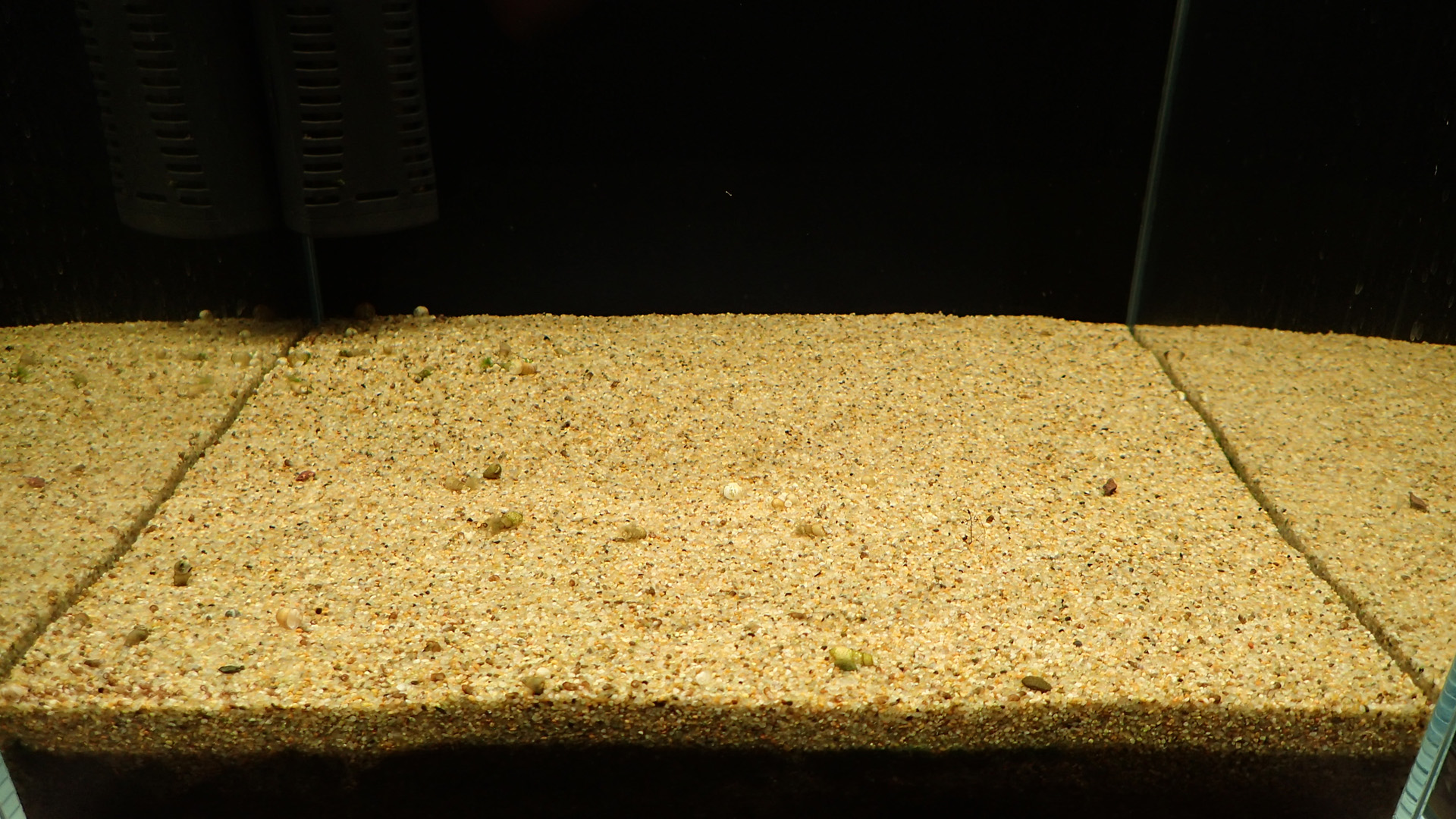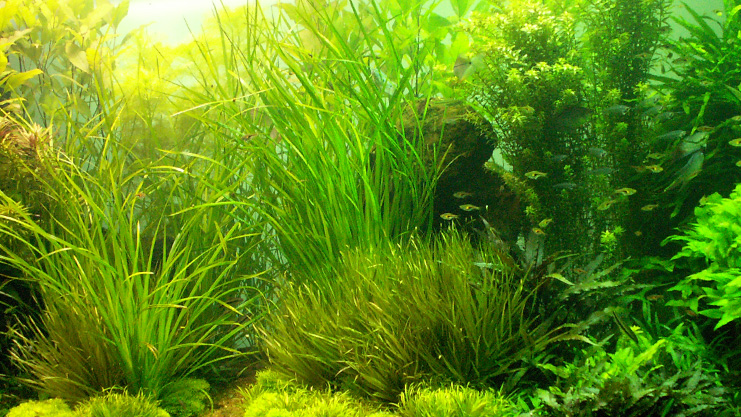From the Aquarium Lab
Substrate Denitrification
Substrate Size Experiment

By Tony Griffitts
Published - 20230921, Revised:
The substrates' role in reducing nitrate in aquatic systems has been known to science for decades. The substrate provides an anoxic environment for anaerobic heterotrophic and autotrophic bacteria and archaea. Some notable beneficial anaerobic processes in the substrate are hydrogen sulfide production, fermentation, methane production, decomposition of detritus, manganese reduction, iron reduction, and denitrification.

In microbiology, anoxic is used to describe environments without molecular oxygen. Anaerobic refers to microorganisms that can live without molecular oxygen. The metabolism bacteria use is also called anaerobic. Easy distinction, anoxic refers to environments, and anaerobic refers to microorganisms and processes.
To achieve an anoxic environment in the substrate, water must flow through at a very slow rate. Aerobic bacteria and organisms need to use up the oxygen in the water before it reaches the anoxic region. If water flows through the substrate too quickly, an anoxic environment will not develop.
This experiment looks at substrate size and depth and its ability to aid in nitrate reduction within a closed system. The research shows that the substrate size matters to achieve denitrification in aquariums.

Three 12-gallon cubes (14" x 14" x 14" [53 L, 35.5 x 35.5 x 35.5 cm]) aquariums were initially set up (2022.11.06) and coupled to provide the same water chemistry and similar microbe biodiversity. Each aquarium was set up with 2 inches (5 cm) of substrate. The first system has 60 mesh (grit) sand, the second 10 mesh sand, and the third set up with pea gravel.
Each aquarium held about 8.25 gallons (31.23 L) of water above the substrate. Evaporation was replaced with tap water which contains no detectable nitrate (Hanna), no detectable phosphate (Hanna), 22 ppm KH (Hanna), 2 dGH (API), 37 ppm TDS (Hanna).




The systems were stocked with fish, shrimp, snails, and aquatic plants to help develop a diverse biome cycle within the aquariums. All fish, shrimp, and plants were removed by 2023.07.07, and the lights were turned off. Three species of snails were allowed to remain in the system:
- Physella acuta (acute bladder snail)
- Planorbella duryi (Seminole ramshorn snail)
- Melanoides tuberculata (Malaysian trumpet snail [MTS])

Temperature in the systems averaged around 80°F (26.7°C) during the experiment.

Filtration and current in each aquarium were supplied by Hygger (sponsor of this research) with the Aquarium Internal Power Filter HG-009-S (SKU: HGB009). The Hygger HG-009-S filter mounts in the corner of the aquarium. In the test systems, it was mounted in the upper left corner.
The filters were configured with the optional spray bar, and the carbon-infused polyester mechanical filtration pads and the sponge were installed. The biological media was left out of the filters to force biological activity within the substrate, consistent with the Planted Aquarium Keep it Simple (PAKIS) method. The spray bars were configured to create a current from left to right and angled towards the surface to aid gas exchange.
The systems were run coupled, and the nitrate, phosphate, KH, GH, TDS, and pH values were collected on 2023.07.30.
Hygger filters were installed in all systems on 2023.07.31.
Systems were decoupled on 2023.08.01.
The following is a list of the equipment and test kits used to collect data:
- Hanna Marine Nitrate High Range Checker HC H1782 (works for freshwater)
- Hanna Low Range Phosphate Checker H1713
- Hanna Freshwater Alkalinity Colorimeter HI775
- Hanna TDS Tester HI98301
- Milwaukee MC120 Pro Digital pH Monitor
- API GH Test Kit
- AMES 12:1 Infrared Laser Thermometer Item 63985
The three tanks were couped with 3/4 in PVC J-tubes to allow the water chemistry values to be consistent across all tanks. Starting values were collected before the three tanks were decoupled.
| Test | Value |
|---|---|
| Nitrate Hanna | 40.6 ppm |
| Phosphate Hanna | 1.32 ppm |
| KH Hanna | 43 ppm |
| TDS Hanna | 202 ppm |
| Temperature AMES | 79° F (26.1° C) |
| GH API | 6 dGH |
| pH at 10:00 AM. | 7.5 |
Below are the tested end values of the three tanks.
Tank #1 60 Mesh Sand (Very Fine Sand)
| Test | Value |
|---|---|
| Nitrate Hanna | 22.2 ppm |
| Phosphate Hanna | 2.23 ppm |
| KH Hanna | 70 ppm |
| TDS Hanna | 217 ppm |
| Temperature AMES | 79° F (26.1° C) |
| GH API | 8 dGH |
| pH at 11:30 AM. | 7.8 |
Tank #2 10 Mesh Gravel (Fine Gravel)
| Test | Value |
|---|---|
| Nitrate Hanna | 55.3 ppm |
| Phosphate Hanna | 1.41 ppm |
| KH Hanna | 59 ppm |
| TDS Hanna | 232 ppm |
| Temperature AMES | 77° F (25° C) |
| GH API | 8 dGH |
| pH at 11:30 AM. | 7.8 |
Tank #3 Pea Gravel
| Test | Value |
|---|---|
| Nitrate Hanna | 48.8 ppm |
| Phosphate Hanna | 1.08 ppm |
| KH Hanna | 56 ppm |
| TDS Hanna | 223 ppm |
| Temperature AMES | 78° F (25.5° C) |
| GH API | 8 dGH |
| pH at 11:30 AM. | 7.8 |
Nitrate dropped in Tank #1 18.4 ppm 34 days, while it increased 14.7 ppm in Tank #2, and 8.2 ppm. Phosphate increased 0.91 ppm in Tank #1, 0.11 ppm in Tank #2, and decreased 0.24 in Tank #3. KH, GH, TDS, and pH increased in all tanks.
| Test | Tank #1 Difference | Tank #2 Difference | Tank #3 Difference |
|---|---|---|---|
| Nitrate Hanna | -18.4 ppm | 14.7 ppm | 8.2 ppm |
| Phosphate Hanna | 0.91 ppm | 0.11 ppm | -0.24 ppm |
| KH Hanna | 27 ppm | 16 ppm | 13 ppm |
| TDS Hanna | 15 ppm | 30 ppm | 21 ppm |
| GH API | 2 dGH | 2 dGH | 2 dGH |
| pH at 11:30 AM. Milwaukee | .3 | .3 | .3 |
The results demonstrate that the very fine 60 mesh sand at 2 inches (5 cm) in depth in Tank #1 provides an anoxic environment for anaerobic bacteria to reduce nitrate. The 2 inches (5 cm) of substrate depth of Tanks #2 and #3 may need to be deeper to reduce nitrate, or it is less efficient than 60 mesh sand.
The increase in KH, GH, TDS, and pH can be attributed to the top-off water not being distilled.
This experiment created more questions than it resolved. Here is a list of unresolved questions:
- The three systems were not fed, and the lights were left off, so the nitrogen production may have been from the snail population dying off. This could account for the elevated nitrate in Tanks #2 and #3.
- Will adding a small amount of sinking pellet food to feed the snails help reduce nitrate?
- Phosphate increased in Tank #1 0.91 ppm and Tank #2 0.11 ppm but decreased by 0.24 ppm in Tank #3. Why?
- Does current play a significant role in nitrate reduction in closed system substrate?
- How deep does the sand bed need to be to show nitrate reduction from anaerobic bacteria?
- Will 2 inches (5 cm) of 30 mesh sand also reduce nitrate?
- What is the minimum depth of 60 mesh sand to achieve nitrate reduction?



